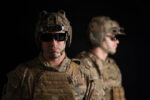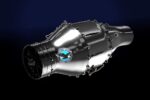At the Association of the United States Army (AUSA) Annual Meeting & Exposition 2025 in Washington D.C., AM General showcased its latest evolution of the Hawkeye Mobile Howitzer System (MHS), a lightweight and highly mobile artillery platform built around a digitally controlled 105mm cannon mounted on a standard Humvee. Designed to meet emerging demands for expeditionary fire support and rapid deployability, the next-generation Hawkeye integrates advanced recoil mitigation technology and networked fire control systems to deliver precision indirect fires from a compact footprint.
Lightweight Firepower for Expeditionary Forces
The Hawkeye MHS is centered around the M20 105mm cannon—derived from the legacy M119—but enhanced with a proprietary soft recoil system (SRS) developed by Mandus Group. This allows the howitzer to be fired from lightweight tactical vehicles without compromising structural integrity or crew safety. The system was originally conceived as a solution for airborne and light infantry units requiring organic artillery support without relying on heavier platforms like the M777 or tracked systems such as the M109A7 Paladin.
Mounted on an AM General Humvee chassis (HMMWV), the Hawkeye’s total system weight remains under 4,500 kg (approx. 10,000 lbs), allowing it to be sling-loaded under CH-47 Chinooks or internally transported in C-130 Hercules aircraft. This mobility profile makes it particularly suited for rapid reaction forces and operations in austere environments where road infrastructure is limited or airlift is essential.
Soft Recoil Technology Enables Lightweight Integration
The key enabler of the Hawkeye’s compact design is its soft recoil system. Unlike traditional howitzers that rely on heavy carriages or stabilizing outriggers to absorb firing shock, the SRS reduces peak recoil forces by up to 70% through controlled counter-recoil mechanisms. This allows direct mounting of the weapon onto light tactical vehicles without external stabilization—a significant departure from conventional artillery doctrine.
Mandus Group’s SRS has been tested extensively since early prototypes debuted in mid-2010s demonstrations. In live-fire trials conducted with U.S. Army units and international partners—including Colombia and Tunisia—the system has proven capable of delivering accurate fires while maintaining vehicle stability across multiple terrain types.
Digital Fire Control Enhances Precision and Responsiveness
The latest iteration of the Hawkeye includes an integrated digital fire control suite that enables rapid targeting and reduced sensor-to-shooter timelines. The onboard ballistic computer interfaces with GPS/INS navigation systems and laser rangefinders to compute firing solutions in real time. This enables single-vehicle operations without reliance on external fire direction centers—ideal for dispersed or decentralized force postures.
The digital architecture also supports integration into broader C4ISR networks via Link-16 or other tactical data links, enabling coordinated fires across joint or coalition formations. According to AM General representatives at AUSA 2025, future upgrades may include AI-assisted targeting algorithms and compatibility with drone-based forward observers for automated target acquisition.
Operational Use Cases: From SOF Support to Contested Littorals
The modularity and transportability of the Hawkeye make it attractive across multiple mission sets:
- Special Operations Forces (SOF): Light enough for air insertion yet potent enough for sustained indirect fire support during raids or raids-in-force missions.
- Littoral Operations: Deployable aboard landing craft or amphibious vehicles for coastal denial missions where heavier artillery cannot be brought ashore quickly.
- Airborne Infantry: Organic fires capability that can deploy alongside paratroopers without waiting for follow-on logistics tails.
- Coalition Interoperability: Especially valuable for partner nations seeking affordable yet NATO-compatible indirect fire solutions that don’t require tracked platforms or extensive training pipelines.
This flexibility aligns well with evolving U.S. Army Multi-Domain Operations (MDO) concepts emphasizing distributed lethality and rapid maneuver across contested theaters such as Indo-Pacific island chains or Eastern European frontlines.
Status of Testing, Procurement Interest & Export Potential
The U.S. Army has conducted limited evaluations of earlier Hawkeye prototypes under its Mobile Protected Firepower initiatives but has not yet committed to full-rate production. However, interest remains high among foreign militaries seeking cost-effective mobile artillery solutions—particularly those operating in mountainous terrain or regions lacking robust road networks.
Tunisia became one of the first international customers to procure an earlier version of the Hawkeye system through U.S. Foreign Military Sales (FMS). Colombia has also tested variants mounted on local chassis platforms such as Toyota Land Cruisers—demonstrating adaptability beyond just HMMWV integration.
At AUSA 2025, AM General officials confirmed ongoing discussions with several NATO-aligned countries exploring fleet modernization options below the caliber threshold of traditional self-propelled howitzers like PzH2000 or K9 Thunder. The company emphasized that production lines are scalable depending on demand—with potential options including JLTV-based variants if higher protection levels are required by end users.
A Competitive Niche Between Mortars and Heavy SPH
The modern battlefield increasingly demands precision strike capabilities at lower echelons without sacrificing mobility—a niche where systems like Hawkeye may thrive. While not matching the range or rate-of-fire of larger self-propelled howitzers (e.g., Caesar NG or Archer), its low logistical footprint and strategic deployability offer unique advantages:
- Simplified logistics: Uses standard NATO-compatible 105mm ammunition; no need for tracked vehicle maintenance chains.
- Crew survivability: Remote firing capability allows crews to operate from cover if needed; minimal setup time reduces exposure during shoot-and-scoot operations.
- Affordability: Estimated unit cost significantly lower than tracked SPHs—attractive for mid-tier militaries facing budget constraints but needing credible deterrence capabilities.
Conclusion: Tactical Agility Meets Strategic Mobility
The next-generation Hawkeye Mobile Howitzer System represents an evolution in light artillery design—merging traditional tube artillery effects with modern mobility requirements and digital integration. As peer threats drive renewed emphasis on dispersed operations across contested domains—from Arctic flanks to Pacific archipelagos—the demand signal for rapidly deployable precision fires will likely grow stronger.
If adopted more widely by U.S. forces or allies under FMS frameworks, systems like Hawkeye could reshape how light forces deliver organic indirect fires—bridging gaps between mortars and heavy SPHs while enabling new operational concepts rooted in speed, agility, and survivability.










